New HP DL980 Servers
You might be surprised, but against the background of triumphant reports about all the new frontiers and slats taken by blades, the good old rack-mounted servers have not gone away and are still capable of a great deal. Moreover, these products are actively developed by all major vendors, with HP at the head, of course. In the end, not every organization or service provider can or wants to acquire or effectively use blade servers, but its park of “ordinary” servers will sooner or later be updated to a new generation of systems. And, perhaps, one of these servers will be the recently released eight-unit DL980 G7.
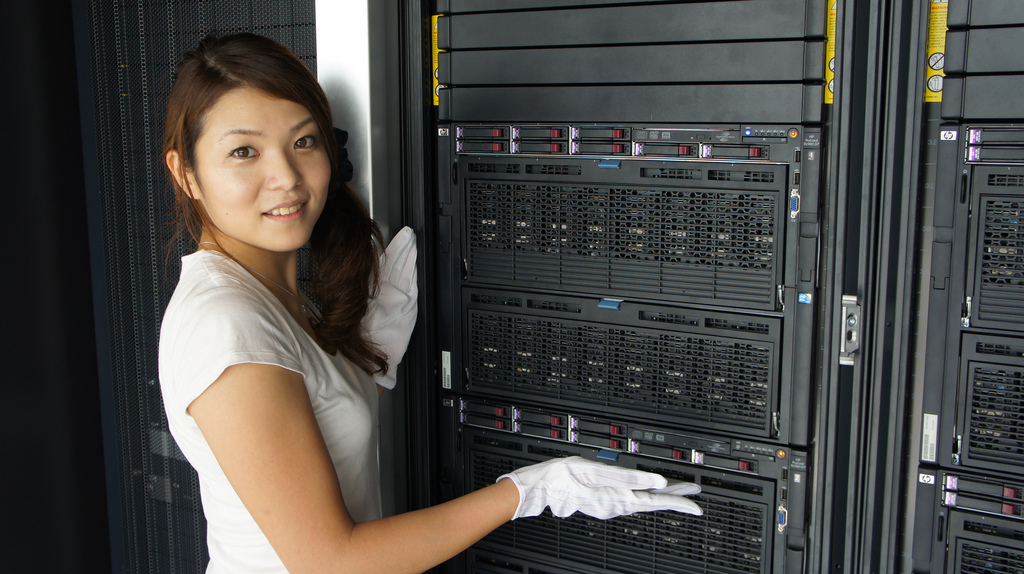
This is a strong and powerful "workhorse", without loud words about supercritical applications and large-scale tasks (which, of course, can also be assigned to it, along with the usual and familiar ones). Up to eight processors of eight ten cores each can be installed in the server today, so the power reserve is not bad: as the new versions are released, the stones can be replaced, or simply added quantitatively if all eight sockets are not occupied right away. Well, what download DL980 can be found in any medium-sized company, not to mention large enterprises. True, it is necessary to make a reservation that by American standards, obviously imposing its imprint on all HP products, an “average company” can easily be considered an office for 1000-2000 employees.
The server is built in an attempt to achieve maximum flexibility and performance in one relatively compact package. Separately emphasizes its compliance with today's realities with rising prices for the operation and maintenance of the server park, together with an explosive increase in the volume of data processed. The seventh generation was not without innovations, there was a place for a certain number of new technologies. In particular, the DL980 G7 uses the PREMA architecture. Its features include a motherboard with redundant components and Smart CPU Caching technology, which provides quick access to local memory and reduces the amount of data transferred during transactions between processors. In terms of processors and memory, everything is generally expected: eight sockets for Xeon processors of the E7 7500/6500 family and 128 memory slots, in which you can install up to 2 TB today and up to 4 TB in the near future. This, as one great innovator said, "should be enough for everyone."
')
Onboard data storage was also not forgotten, there are connectors for eight compact 2.5-inch SAS compact disks in the upper part of the case. Their management is responsible for the integrated disk controller SmartArray 410i. The number of expansion slots reaches 16 pieces, the choice of components from HP and other manufacturers, which can be additionally installed in the DL980 G7, is quite wide. For communication with the outside world is a built-in four-port gigabit controller with the ability to easily replace or add 10-gigabit modules. It is clear that, if desired, the number of ports and connections can be drastically increased by installing expansion cards.
It is good to dwell on the reservation of internal elements, this is one of the main distinguishing features of the new generation. Moreover, the hardware redundancy in the DL980 is used in a very curious way. For example, virtual machines can be isolated at the processor level so that the “broken” data of specific applications does not interfere with other applications or virtual machines. This technology is called “poison-and-recover”.
Another example is the hardware back up of connections at the motherboard level, when in the event of a failure, the system automatically tries to transfer data again, checking the integrity of an alternative connection.
Finally - a few words about the design and control. According to reviews of engineers and system administrators who have already dealt with the DL980 G7, the design was very successful. At the very top of the front panel contains a separate unit with disks, setting them there, you can forget about it - with further installation, it will not interfere. Processors and memory are installed in two separate shelves located one above the other. They both have access from the front panel, the shelves just slide out. This approach, on the one hand, greatly facilitates installation, and on the other hand, it distributes the points of greatest heating over the entire front side, without concentrating them in a separate part of the body. The memory is located in the same shelves, in special compartments for eight slots, which is also a very convenient solution in terms of installation and cooling. You can control and monitor the DL980 G7 using the well-known proprietary technologies iLO3, Insight Control and Thermal Logic.
In general, the server, which received favorable ratings at the time of its first presentation in Las Vegas, makes a good impression on Russian customers. The sysadmins we interviewed especially noted a thoughtful and convenient design, as well as ample opportunities for scaling.
Excellent selection of photos of the HP DL980 G7 from the HPserversJP blog on Flickr (http://www.flickr.com/photos/65907627@N03/page3/):
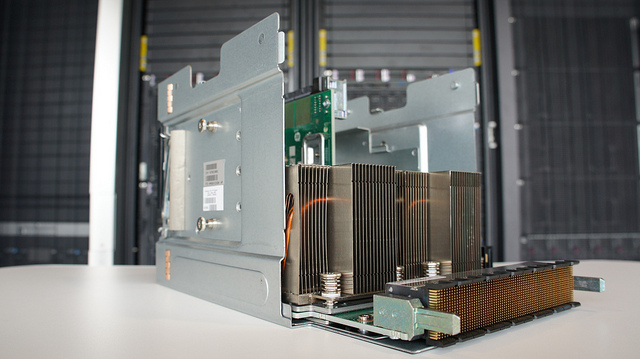

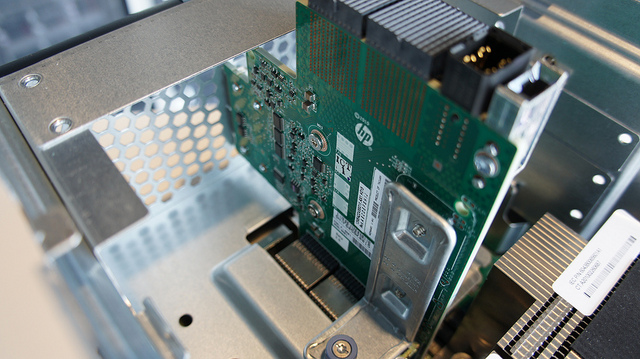


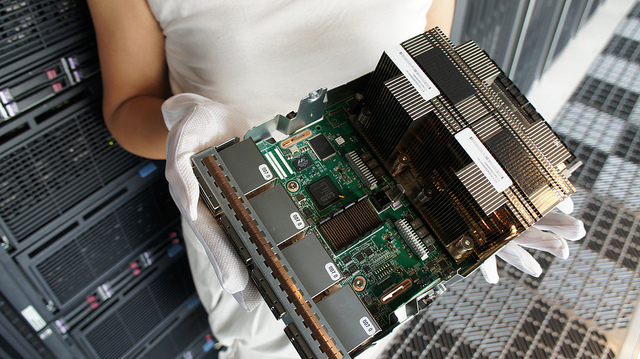

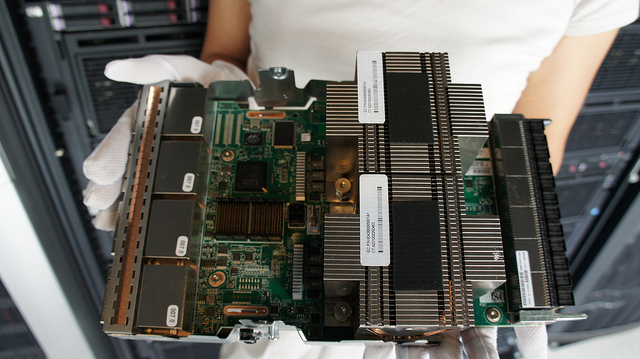
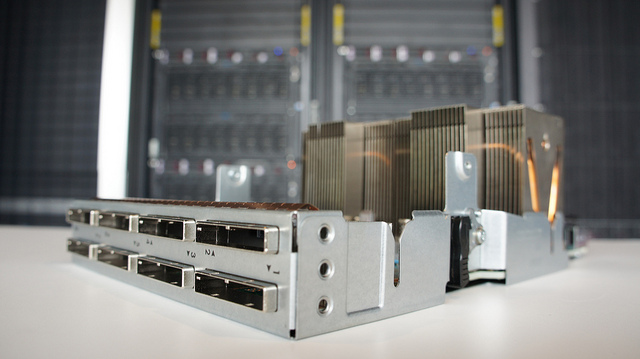




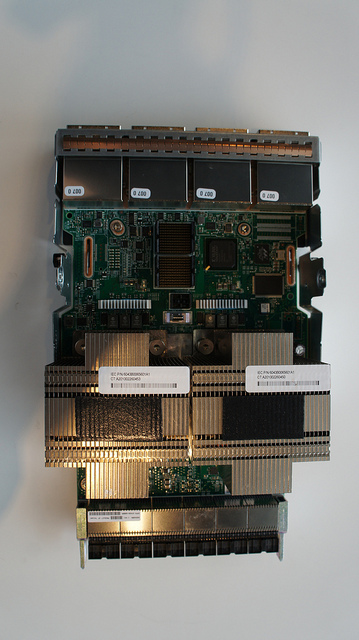




This is a strong and powerful "workhorse", without loud words about supercritical applications and large-scale tasks (which, of course, can also be assigned to it, along with the usual and familiar ones). Up to eight processors of eight ten cores each can be installed in the server today, so the power reserve is not bad: as the new versions are released, the stones can be replaced, or simply added quantitatively if all eight sockets are not occupied right away. Well, what download DL980 can be found in any medium-sized company, not to mention large enterprises. True, it is necessary to make a reservation that by American standards, obviously imposing its imprint on all HP products, an “average company” can easily be considered an office for 1000-2000 employees.
The server is built in an attempt to achieve maximum flexibility and performance in one relatively compact package. Separately emphasizes its compliance with today's realities with rising prices for the operation and maintenance of the server park, together with an explosive increase in the volume of data processed. The seventh generation was not without innovations, there was a place for a certain number of new technologies. In particular, the DL980 G7 uses the PREMA architecture. Its features include a motherboard with redundant components and Smart CPU Caching technology, which provides quick access to local memory and reduces the amount of data transferred during transactions between processors. In terms of processors and memory, everything is generally expected: eight sockets for Xeon processors of the E7 7500/6500 family and 128 memory slots, in which you can install up to 2 TB today and up to 4 TB in the near future. This, as one great innovator said, "should be enough for everyone."
')
Onboard data storage was also not forgotten, there are connectors for eight compact 2.5-inch SAS compact disks in the upper part of the case. Their management is responsible for the integrated disk controller SmartArray 410i. The number of expansion slots reaches 16 pieces, the choice of components from HP and other manufacturers, which can be additionally installed in the DL980 G7, is quite wide. For communication with the outside world is a built-in four-port gigabit controller with the ability to easily replace or add 10-gigabit modules. It is clear that, if desired, the number of ports and connections can be drastically increased by installing expansion cards.
It is good to dwell on the reservation of internal elements, this is one of the main distinguishing features of the new generation. Moreover, the hardware redundancy in the DL980 is used in a very curious way. For example, virtual machines can be isolated at the processor level so that the “broken” data of specific applications does not interfere with other applications or virtual machines. This technology is called “poison-and-recover”.
Another example is the hardware back up of connections at the motherboard level, when in the event of a failure, the system automatically tries to transfer data again, checking the integrity of an alternative connection.
Finally - a few words about the design and control. According to reviews of engineers and system administrators who have already dealt with the DL980 G7, the design was very successful. At the very top of the front panel contains a separate unit with disks, setting them there, you can forget about it - with further installation, it will not interfere. Processors and memory are installed in two separate shelves located one above the other. They both have access from the front panel, the shelves just slide out. This approach, on the one hand, greatly facilitates installation, and on the other hand, it distributes the points of greatest heating over the entire front side, without concentrating them in a separate part of the body. The memory is located in the same shelves, in special compartments for eight slots, which is also a very convenient solution in terms of installation and cooling. You can control and monitor the DL980 G7 using the well-known proprietary technologies iLO3, Insight Control and Thermal Logic.
In general, the server, which received favorable ratings at the time of its first presentation in Las Vegas, makes a good impression on Russian customers. The sysadmins we interviewed especially noted a thoughtful and convenient design, as well as ample opportunities for scaling.
Excellent selection of photos of the HP DL980 G7 from the HPserversJP blog on Flickr (http://www.flickr.com/photos/65907627@N03/page3/):

















Source: https://habr.com/ru/post/134002/
All Articles